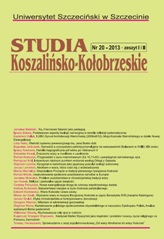Kameduli a uroczystości patriotyczno-religijne na warszawskich Bielanach w XVIII i XIX wieku
The Camaldolese monks and patriotic and religious celebrations in Warsaw Bielany during eighteenth and nineteenth century
Author(s): Bogusław JankowskiSubject(s): Christian Theology and Religion, Customs / Folklore, 18th Century, 19th Century
Published by: Wydawnictwo Naukowe Uniwersytetu Szczecińskiego
Keywords: Bielany; Drozdowicz Wojciech ks.; Hermits; Camaldoli Hermitage; Polkowa Mountain; Jan Kazimierz – the king; Jan III Sobieski; Camaldolese; Camaldoles Priory; Warsaw Church; Las Bielański;
Summary/Abstract: Who were the Camaldolese monks – so closely associated with the Church and the Polish nation? What is their role in the development of patriotism and religion? Why have the Polish invaders so vigorously fought against the order of hermits who by their apparent closure seemed harmless. Finally, why at such close observation and detachment from the outside world, did the ermitorium in Bielany held boisterous dances and festivities bringing together many people of Warsaw. These questions are to be answered by this paper. Although short by necessity, it will at first present the characteristics of the Camaldolese order. They are brothers founded by St. Romuald in the tenth century. Despite of the very strict Rule, requiring permanent residence in the monastery, strict silence and poor food the quantity of the brothers in the order very quickly grew. At the time of rapid establishment of many new monasteries, the Polkowa Gora monastery in Bielany was also founded. Here in the seventeenth century the monks settled being previously invited and equipped by King Wladyslaw IV. The process of building and finishing of the hermitages and the church continued throughout the seventeenth and eighteenth century. However, they had numerous religious donors and powerful protectors. These include, among others, Polish kings – already mentioned Wladyslaw IV, John Casimir, Michael Korybut Wisniowiecki and John III Sobieski. In the nineteenth century in the Warsaw ermitorium the Vicar General of the Order resides being in charge of all the order houses in Poland. Unfortunately, the situation of the community is closely linked to the difficult and in fact tragic history of Poland, which was the glory and the victory of Vienna resulting in falling into a growing dependence of the neighbor countries and finally being divided between Russia, Prussia and Austria. The time of struggle for independence, Kosciuszko Insurrection and uprisings do not avoid Bielany. Although located far from the city, for the struggling for independence Bielany were regarded as a place of rest, and a hideout from pursuers. For this reason, the invaders, especially after the third partition of Poland, as a priority decided to destroy the place that they knew helped the uprisers. The existence of novitiate was forbidden and some of the fathers were deported to Siberia. The history of Camaldolese monastery on Polkowa Gora has come to an end in 1904 when the last three fathers were transported to the New Town. It can, therefore, surprise that the fathers of Camaldolese monks so readily accepted by their ermitorium boisterous fun events, firstly associated with indulgence, and in later years with frequent picnics and celebration of various patriotic anniversaries. The tradition of religious and cultural celebrations originated as early as the seventeenth century. King Wladysław IV managed to obtain from the Pope the Pentecost indulgence. In June 19, 1673 with the involvement of the king and the nobility of the St. John the Baptist Collegiate Church the image of St. Bruno Boniface was relocated. Since that time indulgences in Bielany contain religious and patriotic character. Especially during the partitions period in the history, people of Warsaw thought as their obligation to come and take part in the Camaldolese celebrations, even though they were not welcomed by the partitioning powers. The old tradition of celebrating the Pentecost continues to this day. That is why every year there is a procession with the image of St. Bruno Boniface. During the celebration of Pentecost the surrounding forest is always filled with sounds of joyful games and songs bringing together people of Warsaw.
Journal: Studia Koszalińsko-Kołobrzeskie
- Issue Year: 2013
- Issue No: 20
- Page Range: 59-72
- Page Count: 14
- Language: Polish

